When organizing a commercial refrigerator, the first question often is: “What goes on the top shelf?” To answer the question directly, several experts recommend that ready-to-eat foods be stored on the top shelf. The reasons for this are worth discussing as they reveal critical insights into food safety, efficient management, and overall effectiveness in a commercial kitchen. So, what are ready-to-eat foods, and why must they be stored on the top shelf in a commercial refrigerator?
WHAT ARE “READY-TO-EAT” FOODS?
“Ready-to-eat foods” describe any food that can be consumed without any further preparation, cooking, or processing. Thus, the following food kinds are classified as “ready-to-eat.”:
- Cooked foods: Cooked foods include all food items that have been thoroughly cooked and are ready for service, such as soups, stews, and roasted meats.
- Dairy products: Milk, cheese, yogurt, and other dairy products that are consumed as they are.
- Deli meats: Pre-cooked and sliced meats like those used in sandwiches and salads.
- Prepared salads: Freshly made salads and pre-packaged salads ready for immediate consumption.
- Cooked meats and seafood: Foods that have been cooked and need no further preparation before being served.
WHY READY-TO-EAT FOODS MUST BE STORED ON THE TOP SHELF
TO PREVENT THE RISK OF CROSS-CONTAMINATION
The primary reason for storing ready-to-eat foods on the top shelf is to prevent cross-contamination. Cross-contamination occurs when harmful bacteria or allergens are transferred from one food item to another and can result in potential foodborne illnesses. In a commercial kitchen, cross-contamination can occur through direct contact or dripping liquids.
Preventing Dripping Liquid Contamination
Raw foods, especially meats, poultry, and seafood, can carry pathogens like Salmonella, E. coli, and Listeria. These pathogens can be present in the juices and fluids that raw foods release. If these fluids drip onto ready-to-eat foods, the pathogens can contaminate them, posing a severe health risk.
By storing ready-to-eat foods on the top shelf, you ensure that any juices or liquids from raw foods stored below cannot contaminate them. This practice is essential in maintaining a safe food storage environment and preventing foodborne illnesses.
TO MAXIMIZE TEMPERATURE CONTROL AND ENSURE FOOD SAFETY
Commercial refrigerators are designed to keep food at safe temperatures, typically below 40°F (4°C), to slow down the growth of bacteria. Preventing bacterial growth is critical for maintaining the safety and quality of all food items. However, different types of foods require different storage temperatures.
Ready-to-eat Foods are Highly Temperature-Sensitive
Ready-to-eat foods, particularly dairy products and pre-cooked items are highly susceptible to temperature changes. Storing these items on the top shelf, where the temperature is generally more consistent and slightly warmer, ensures they remain within the safe temperature range. This practice helps in preserving the quality and safety of these foods.
TO FACILITATE ORGANIZATIONAL EFFICIENCY IN A BUSY KITCHEN
A commercial kitchen is a fast-paced environment where efficiency is crucial. Properly organizing the refrigerator can significantly enhance workflow and productivity.
The Top Shelf is Easy to Access
Storing ready-to-eat foods on the top shelf makes them easily accessible and visible to kitchen staff. When preparing meals, chefs and cooks can quickly locate and pick up these items, reducing the time spent searching for ingredients. This efficiency is particularly important during peak hours when the kitchen is busiest.
TO COMPLY WITH FOOD SAFETY REGULATIONS
Food safety regulations and guidelines are established to protect consumers and ensure that food establishments maintain high standards of hygiene and safety. Compliance with these regulations is not only a legal requirement but also a moral obligation for food service providers.
It Is Recommended for Food Safety
Storing ready-to-eat foods on the top shelf is a widely recognized best practice in the food industry. It aligns with guidelines provided by food safety authorities such as the Food and Drug Administration (FDA) and the Centers for Disease Control and Prevention (CDC). Adhering to these guidelines helps prevent foodborne illnesses and ensures your establishment meets regulatory standards.
IT'S NOT JUST ABOUT THE TOP-SHELF
Storing ready-to-eat foods on the top shelf is vital for maintaining food safety, preventing food contamination, and ensuring efficiency and accessibility. However, implementing effective food storage practices in your commercial kitchen goes beyond what happens on the top shelf. Here are some additional essentials for maintaining food safety and quality in your commercial refrigerator:
- Label and Date: Label and date all food items to ensure proper rotation and usage within safe time frames.
- Separate Raw and Ready-to-Eat Foods: Always store raw meats, poultry, and seafood on lower shelves to prevent drip contamination.
- Use Proper Containers: Store ready-to-eat foods in airtight containers to protect them from contaminants and odors.
- Regular Cleaning: Clean and sanitize the refrigerator regularly to prevent bacteria and mold buildup.
- Monitor Temperatures: Use thermometers to check and record the refrigerator's temperature regularly.
START WITH THE RIGHT REFRIGERATOR
By prioritizing the safe storage of ready-to-eat foods, commercial kitchens protect their customers, uphold their reputation, and operate smoothly in a fast-paced environment. Implementing these best practices is vital to achieving excellence in food safety and quality.
Another best practice would be ensuring that the commercial kitchen always acquires top-quality commercial refrigerators. It is no secret that best practices go only as far as the quality of the equipment used. Wilprep Kitchen is a top provider of reliable commercial kitchen equipment, including refrigerators, food warmers, commercial ranges, and industrial ovens. Wilprep’s collection of commercial refrigerators contains a variety of models, including display refrigerators, reach-in, and open-air merchandisers, to suit the needs of diverse businesses. Check out Wilprep for the right materials to grow your business and more information on implementing best practices in your commercial kitchen, including a guide on selecting the ideal refrigerator.










